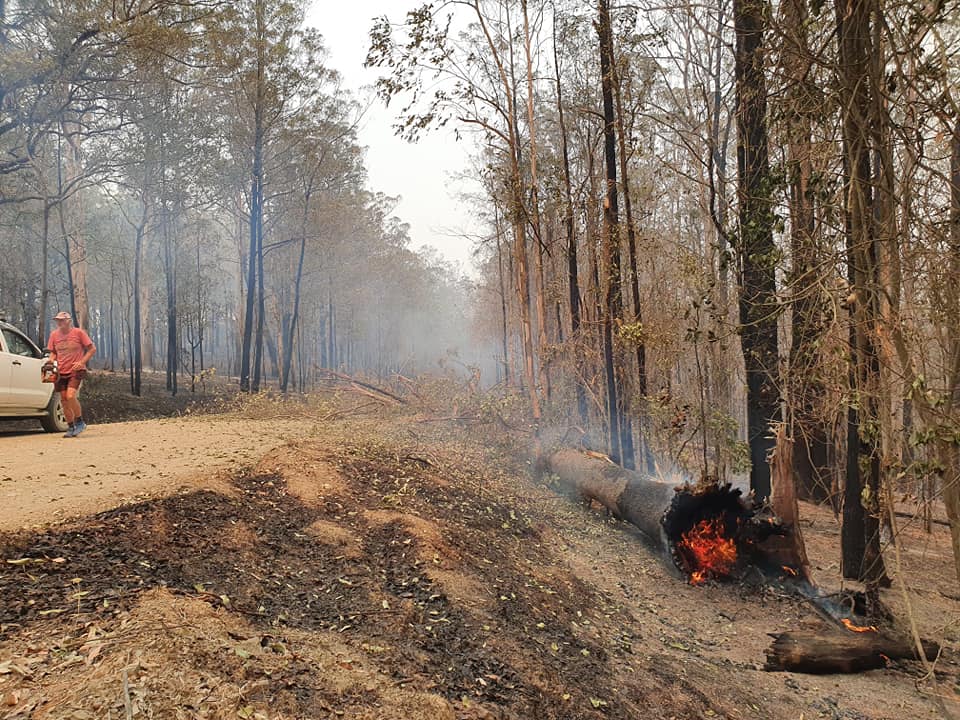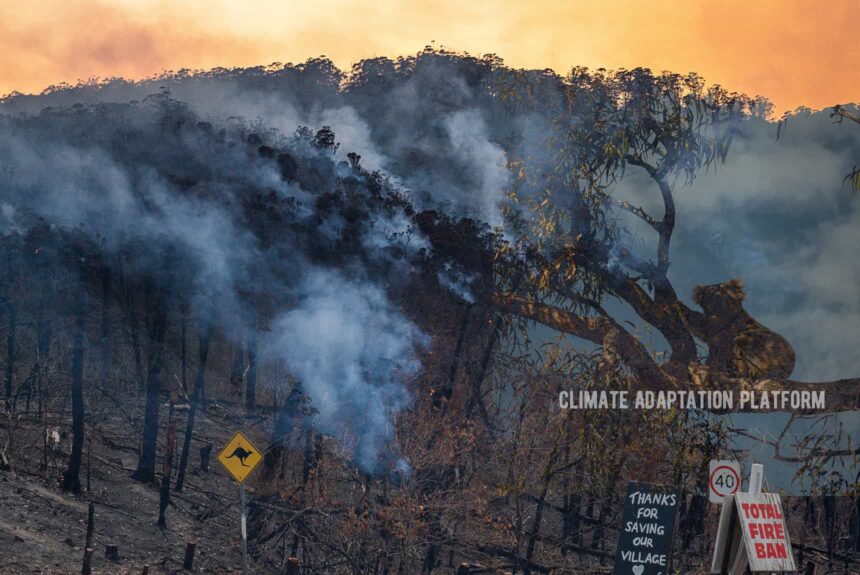As bushfires continue to rage across New South Wales, as of the writing of this blog, it has ravaged 150 properties, killing three people and leaving 100 more injured, including 20 firefighters. More than 60 bushfires are still active and controlled by around 1300 firefighters ( McGowan et al., 2019, November 11).
Shane Fitzsimmons, premier and commissioner of the Rural Fire Service, declared a catastrophic fire danger warning for large areas of the state, including the greater Sydney area. He said that fires are starting extremely quickly, easily and spreading very, very quickly, McGowan et al. added.
Climate Change and Bushfires
“Climate change is making a bad situation worse,” says David Bowman in his opinion article “, The causes of unprecedented bushfires are complex, but climate change is part of the puzzle” (Bowman, 2019).
Bushfires this year have come early, around six weeks before the summer season formally starts. However, ‘out-of-control’ bushfires have already begun in eastern parts of Australia and have claimed two lives ( Lucas & Harris, 2019).
Bowman (2019) expresses further:
- Bushfires involve fuel management, firefighting techniques, landscape planning, building design and environmental history.
- Bushfires are an ancient presence in Australia. For over 40,000 years, Aboriginal people have skillfully managed fires to sustain biodiversity and reinforce vegetation boundaries, such as the edges between forests and grasslands.
What contributes to bushfires?
The article “What are the links between climate change and bushfires? – explainer” mentions the following factors that contribute to bushfires:
- Dryness, temperature, fuel load, wind speed, and humidity contribute to bushfires.
- Hot weather increases bushfire risks. According to the Bureau of Meteorology, Australia’s temperature has increased by 1 degree Celsius since 1910. The IPCC says that the increase in temperature was caused by the greenhouse gas concentrations in the atmosphere.
- The increasing amount of dry fuel loads, such as forest and scrub, is linked to increased carbon emissions because carbon acts like a fertiliser to plants and boosts their growth.
- Higher temperatures accelerate evaporation and extend the growing season for vegetation in many parts of Australia. When water is drawn out from the soil and evaporates from the leaves and flowers, this results in increased evaporation, which would result in drier air even if there was the same rain.
- Weather patterns show that summer has been hot from 2019 to 2020 and dry for large parts of Australia. January 2019 was the hottest month, July was the third hottest month, and October was the hottest day in some areas.
The “What are the links” article shared a link to the research article, “Understanding the variability of Australian fire weather between 1973 and 2017,” which is a study on understanding more about the bushfire phenomenon, the seasonal fire weather history for 44 years at 39 weather stations, analysis of the study points to the strong relationship between climate drivers like El Niño, climate change and the Australian bushfire season.
To help us understand more, the Bureau of Meteorology has published the video “Understanding Fire Weather.”
Indigenous burning, a solution to prevent massive bushfires?
The ideal approach to bushfire management would be to reinstate these Indigenous burning practices, but drastic changes over the last 200 years have made this impossible in many settings (Bowman, 2019).
The council controls wildfires using the indigenous fire management program in Kimberly, Australia. Highly skilled Indigenous rangers use traditional knowledge, techniques, and modern science and technology to fight fire with fire (Indigenous Fire Management, 2019).
“Indigenous Fire Management” (2019) says that this traditional use of fire management has mainly been halted due to colonisation and removal of Aboriginal people from traditional lands. Conventional burning was stopped. Large and uncontrolled wildfires usually emerge in the dry season and impact grazing pastures, infrastructure, and other assets.
How is indigenous fire management done?
“The knowledge is held within the landscape. Once we learn how to read that landscape and interpret that knowledge, we can apply those fire practices,” explains Aboriginal community member Noel Webster (Korff, 2019).
Korff (2019) explains more about Aboriginal fire management:
- It involves the lighting of ‘cool’ fires in targeted areas during the early season between March and July. The fire burns slowly, creating fire breaks, and not all sites are burnt; rather, it creates a ‘mosaic’ of the burnt and unburnt country.
- This method removes fuel for larger fires when the season is scorching and maintains and protects habitats for mammals, reptiles, insects and birds.
Bowman discusses this further in his article, “Aboriginal fire management—part of the solution to destructive bushfires.”

Australia’s commitment to climate change
If climate change is responsible for the occurrence and escalation of bushfires, then Australia needs to undertake climate change adaptation and mitigation projects.
With Australia as the world’s largest coal exporter, its commitment to reduce carbon emissions by 26 to 28 per cent is doubted by many.
PM Morrison said that addressing climate change is “balancing our global responsibilities with sensible and practical policies to secure our environment and our economic future” (“Is climate change to blame,” 2019).
“Is climate change to blame” (2019) quotes Dr Richard Thorton, chief executive of the Bushfires & Natural Hazards Co-operative Research Centre: “We find it very difficult in general to attribute climate change impacts to a specific event..but what we do know is that the average temperature in Australia is now running about 1 C above the long-term average.”
“It’s not every weather event that is the direct result of climate change, but when you see trends…it becomes undeniably linked to global climate change,” says Prof Glenda Wardle, an ecologist from the University of Sydney ( (“Is climate change to blame,” 2019).
Dr Thornton expects that, as temperatures increase, Australia’s bushfires will become more extreme and occur more frequently (“Is climate change to blame?” 2019).
For us who are reading this article and who might be watching within the comfort and safety of our respective places the news updates about the bushfires in Australia that are happening now or in the past, we can only imagine the hardship that people, animals, flora and fauna, the environment, are going through. Also, we all know that losing life and property could be one’s worst and most haunting nightmare.
Will we see a consistent and sustainable solution soon? Should the Australian government and people consider developing more climate adaptation solutions and strategies as bushfires occur now and then?
Sources:
McGowan, M. et al. (2019, November 11). NSW fires. Almost 600 schools closed today. The Guardian. Retrieved from https://www.theguardian.com/australia-news/2019/nov/11/nsw-fires-premier-declares-state-of-emergency-amid-most-devastating-bushfires-ever-seen
Lucas C. & Harris, S. (2019, October 11). Climate change partly to blame for early bushfire season. The Guardian. Retrieved from https://www.theguardian.com/australia-news/2019/oct/11/climate-change-partly-to-blame-for-early-bushfire-season
What are the links between climate change and bushfires? – explainer. (2019, November 10). The Guardian. Retrieved from https://www.theguardian.com/australia-news/2019/nov/11/what-are-the-links-between-climate-change-and-bushfires-explainer
Bowman, D. (2016, February 23). Aboriginal fire management – part of the solution. The Conversation. Retrieved from https://theconversation.com/aboriginal-fire-management-part-of-the-solution-to-destructive-bushfires-55032
Understanding Fire Weather. (2019, August 28). Bureau of Meteorology [Video file]. Retrieved from https://www.youtube.com/watch?v=Jt1PCnSiqQI&feature=emb_logo
Indigenous Fire Management. (2010). Kimberly Land Council. Retrieved from https://www.klc.org.au/indigenous-fire-management
Korff, J. (2019, November 3). Aboriginal fire management. Creative Spirits. Retrieved from https://www.creativespirits.info/aboriginalculture/land/aboriginal-fire-management
Is climate change to blame for Australia’s bushfires? (2019, November 11). BBC news. Retrieved from https://www.bbc.com/news/world-australia-50341210
PHOTO CREDIT:
- Elands, NSW by Jarra Hickstar



Leave a Reply